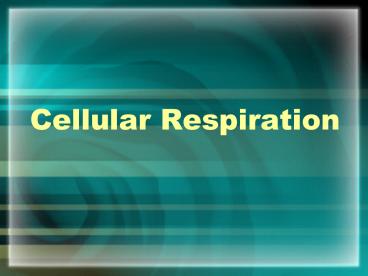Cellular Respiration - PowerPoint PPT Presentation
1 / 11
Title:
Cellular Respiration
Description:
Aerobic requiring oxygen ... can build up in muscles during strenuous exercise and cause burning and soreness. ... Equation for Aerobic respiration: C6H12O6 ... – PowerPoint PPT presentation
Number of Views:52
Avg rating:3.0/5.0
Title: Cellular Respiration
1
Cellular Respiration
2
Respiration An Overview
- The process by which cells break down food
sources such as glucose, fats, and protein and
release their stored energy. - Two main types
- Anaerobic no oxygen required
- Aerobic requiring oxygen
- Both forms produce energy storage molecules
called ATP adenosine triphosphate.
http//www.chemistry.wustl.edu/courses/genchem/La
bTutorials/Cytochromes/images/flowchart1.jpg
3
Anaerobic Processes
- No oxygen is required for these processes.
- Includes glycolysis, the breakdown of glucose,
and fermentation. - Some bacteria and yeast are examples of anaerobes.
http//www.biol.vt.edu/research/images/C._perfring
ens_in_mac._jpg.jpg
http//www.utoronto.ca/greenblattlab/images/a/yeas
t201.jpg
4
Glycolysis
- Occurs in the cytoplasm.
- Breaks down glucose into 2 molecules of pyruvate
(3-carbon structures) - 2 ATP molecules are formed.
- 2NADH energy shuttles are also formed.
- This pyruvate is further metabolized during
fermentation
http//www.emc.maricopa.edu/faculty/farabee/BIOBK/
enyld1.gif
5
Fermentation
- Pyruvate can be metabolized by
- Alcoholic fermentation
- Lactic acid fermentation
- AF produces ethyl alcohol and CO2 yeast can
ferment apple juice to fill a balloon. - LAF produces lactic acid. It can build up in
muscles during strenuous exercise and cause
burning and soreness.
6
Aerobic Processes
- Requires oxygen.
- Most organisms are aerobes.
- Equation for Aerobic respiration
- C6H12O6 6O2 ? 6CO2 6H2O Energy
- Based on this equation Why do we breathe?
http//www.oum.ox.ac.uk/thezone/animals/life/image
s/excrete.gif
7
The Mitochondria
- If O2 is present following glycolysis, pyruvate
is modified and enters the mitochondria. - Here food is broken down completely into CO2.
- Energy storage molecules like NADH and ATP are
produced. This is why the mitochondria is called
the power house of the cell.
8
The Role of Oxygen
- Energy carriers like NADH drop off electrons and
as they fall to oxygen during metabolism energy
is stored in a payload of ATP. - Oxygen picks up electrons and hydrogen ions to
form water.
H2O
9
ATP Adenosine Triphosphate
- ATP is the cells energy currency.
- Cellular work such as metabolism, transport, and
movement is powered by the breakdown of ATP. - ATP Structure
- Ribose a 5-carbon sugar
- Adenine a N-base
- 3 phosphate groups
10
ATP / ADP Cycle
- ATP is constantly being used and remade in the
cell. - Energy is released or stored by breaking or
making a phosphate bond.
http//www.columbia.edu/cu/biology/courses/c2005/p
urves6/figure06-09.jpg
11
Summary of Cellular Respiration































